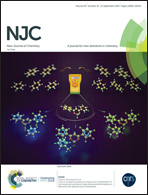A newly designed anthracene and isoindigo based polymer: synthesis, electrochemical characterization and biosensor applications
Abstract
A glucose biosensor based on a newly designed and synthesized polymer, poly[(E)-6-methyl-6′-(10-methylanthracen-9-yl)-1,1′-diundecyl-[3,3′-biindolinylidene]-2,2′-dione] (namely PIIDAnth), and single walled carbon nanotubes (SWCNTs) was fabricated via an easy one pot electrode preparation and explored as a glucose electrochemical sensor. The key aim of this paper is to emphasize creation of the new surface design of sensing platforms based on a novel polymer and nanomaterial for glucose detection. With the insertion of single walled carbon nanotubes (SWCNTs) into the biosensing system the sensor showed remarkable advantages for glucose detection including high sensitivity and low detection limit. In addition, electrochemical analysis of the polymer was investigated. The enzyme biosensor showed a linear range from 0.05 mM to 1.0 mM (R2 = 0.994) with a great sensitivity of 61.23 μA mM−1 cm−2 and low detection limit of 0.026 mM. The apparent Michaelis–Menten constant (KappM) was estimated to be 0.8 mM. Cyclic voltammetry (CV) and scanning electron microscopy (SEM) images revealed the electrochemical and morphologic features. The fabricated sensor was also tested in commercial beverages, successfully. Amperometric measurements proved that PIIDAnth/SWCNT/GOx coating is an excellent structure for glucose sensing.



 Please wait while we load your content...
Please wait while we load your content...